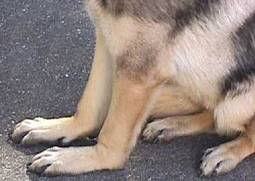|
What is a Carpal Hyperextension Injury? By Topdoghealth A hyperextension injury is severe damage of the ligaments that supports the wrist (or carpus) of the forelimb. On the back of the carpus, the palmar fibrocartilage supports the joint and prevents it from overextending. When the fibrocartilage is damaged, the carpus is no longer held in flexion, and this causes the paw to sink down to the ground during weight-bearing. Carpal hyperextension injuries are also called carpal luxations or subluxations. Who gets a Carpal Hyperextension Injury? Dogs of any age, breed, or gender can suffer a carpal hyperextension injury, but it most commonly occurs in performance and agility animals, and active large breed dogs. It can also occur in smaller breeds, as well as cats.
|
|
How is a Carpal Hyperextension Injury Diagnosed?
Your veterinarian can diagnose a carpal hyperextension injury by taking a thorough history and physical exam. Upon palpation, instability will be present, and the carpus can be manipulated into greater extension than normal. The veterinarian will also take radiographs to identify the exact location of the instability of the carpus. Why did my Dog get a Carpal Hyperextension Injury? Carpal hyperextension injuries usually occur as a result of jumping or falling from a high surface, and are usually due to a single isolated traumatic event. In some cases, it can be due to repeated injury to the area, such as from jumping off elevated surfaces or out of a vehicle. Agility and performance dogs are prone to such injuries. If there is no history of injury and hyperextension has developed slowly, immune-mediated joint disease or degenerative conditions of the ligaments may be the cause. |
|
How is a Carpal Hyperextension Injury Treated?
The carpus is composed of three separate joints. Therefore, treatment depends on which and how many of those joints have been compromised. If all the joints are broken down, or the just the top joint, surgery must be performed to fuse the entire carpal joint. A partial fusion may be recommended if only the last two joints are compromised. Fusion of the joints is called arthrodesis. First, all cartilage on the bones of the joint is removed, and a bone graft that has been collected from the patient’s humerus is packed into the joint spaces. The bones are then stabilized by plates and screws. A full arthrodesis will remove all movement within the carpus, whereas a partial arthrodesis retains about 50 to 75% of normal range of motion of the carpus. After surgery, a cast or splint is applied to the limb to support the repair for about 4-6 weeks. In most cases, splinting the carpus alone is not beneficial, because the scar tissue that forms as the injury heals is not strong enough to support the amount of stress and force that is placed on the carpus with normal activity. Can a Carpal Hyperextension Injury be Prevented? The best way to prevent a carpal hyperextension injury is by preventing the dog from jumping from high surfaces. Athletic dogs should be properly conditioned. Weight management is important as well. What is the Prognosis for my Dog with a Carpal Hyperextension Injury? Surgical arthrodesis will relieve the dog’s pain once the bones have fused together. A partial arthrodesis commonly will allow your pet to have normal function of the limb with good range of motion of the carpus. A full arthrodesis of the carpus typically results in good function of the limb; however, a gait abnormality is expected, since the carpus will not have any movement. In general, about 90 to 95% of the patients will respond well to the surgery. However, full recovery with just medical management, especially in large breed dogs is guarded. |
**Canine Arthritis And Joint is intended for informational, educational and entertainment purposes only and is not a substitute for medical advice, diagnosis or treatment. Do not attempt to self-diagnose or treat any health condition. You should always consult with a healthcare professional before starting any diet, exercise or supplementation program, before taking any medication, or if you have or suspect your pet might have a health problem. The opinions expressed by Canine Arthritis And Joint are not to be replaced for medical care. This website and the information contained herein have not been evaluated by the Food and Drug Administration. The information and opinions on Canine Arthritis And Joint are not intended and cannot be used to diagnose, treat, cure, or prevent any disease. This applies to people and pets!
This site uses affiliate links such as banners you may see that allows for paid commissions.
This site uses affiliate links such as banners you may see that allows for paid commissions.
Canine Arthritis And Joint © Copyright 2015-2024
Designed By Paw Prints Web Design
Designed By Paw Prints Web Design









